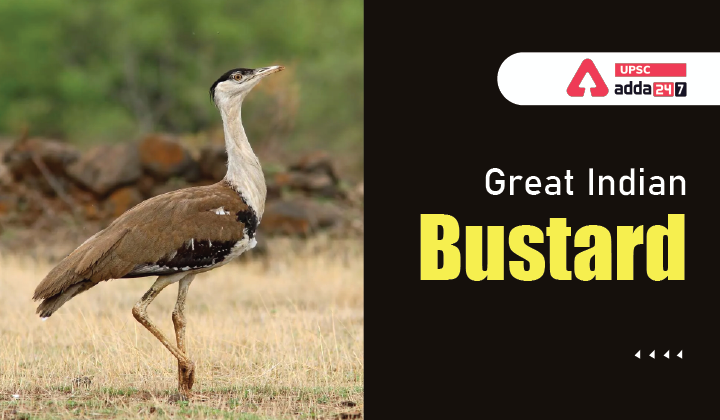Table of Contents
Great Indian Bustards- Relevance for UPSC Exam
- GS Paper 3: Environment- Conservation, environmental pollution and degradation.
Great Indian Bustards in news
- As per the studies conducted by Wildlife Institute of India, there are around 150 Great Indian Bustards left across the country.
- These includes about 128 birds in Rajasthan and less than 10 birds each in the States of Gujarat, Maharashtra, Andhra Pradesh and Karnataka.
Great Indian Bustards
- About: Great Indian Bustards (GIBs) are the largest among the four bustard species found in India, the other three being MacQueen’s bustard, lesser florican and the Bengal florican.
- Habitat: In India, GIBs are confined mostly to Rajasthan and Gujarat. Small populations occur in Maharashtra, Karnataka and Andhra Pradesh.
- Preferred Habitation: Great Indian Bustards (GIBs) prefer grasslands as their habitats.
- Being terrestrial birds, they spend most of their time on the ground with occasional flights to go from one part of their habitat to the other.
- Feeding Pattern: Great Indian Bustards (GIBs) feed on insects, lizards, grass seeds etc.
- Importance: GIBs are considered the flagship bird species of grassland and hence barometers of the health of grassland ecosystems.
Conservation Status of Great Indian Bustards (GIBs)
- IUCN Status: IUCN has categorised GIBs as critically endangered.
- Convention on International Trade in Endangered Species of Wild Fauna and Flora (CITES): GIBs are listed under Appendix 1 of the CITES.
- Convention on Migratory Species (CMS): GIBs are listed under Appendix I of CMS.
- Great Indian Bustard was also the mascot of the prestigious 13th CMS Conference of Parties held in Gandhinagar, Gujarat.
- Wildlife (Protection) Act, 1972: Great Indian Bustards are listed under Schedule 1 of the WPA Act 1972.
Threats to Great Indian Bustards (GIBs)
- Power Transmission Lines: WII have been pointing out overhead power transmission lines as the biggest threat to the GIBs.
- WII research has concluded that in Rajasthan, 18 GIBs die every year after colliding with overhead powerlines.
- This happens due to their poor frontal vision, as they can’t detect powerlines in time and their weight make in-flight quick manoeuvres difficult.
- Development of Renewable energy infrastructure: Kutch and Thar desert are the places which have witnessed creation of huge renewable energy infrastructure over the past two decades.
- These energy infrastructures are leading to installation of windmills and construction of power lines even in core GIB areas, causing deaths of Great Indian Bustards.
- Change in Land use pattern: Change in landscape by way of farmers cultivating their land, which otherwise used to remain fallow due to frequent droughts in Kutch.
- Cultivation of cotton and wheat instead of pulses and fodder are also cited as reasons for falling GIB numbers.
Environmental Performance Index 2022





 TSPSC Group 1 Question Paper 2024, Downl...
TSPSC Group 1 Question Paper 2024, Downl...
 TSPSC Group 1 Answer key 2024 Out, Downl...
TSPSC Group 1 Answer key 2024 Out, Downl...
 UPSC Prelims 2024 Question Paper, Downlo...
UPSC Prelims 2024 Question Paper, Downlo...





